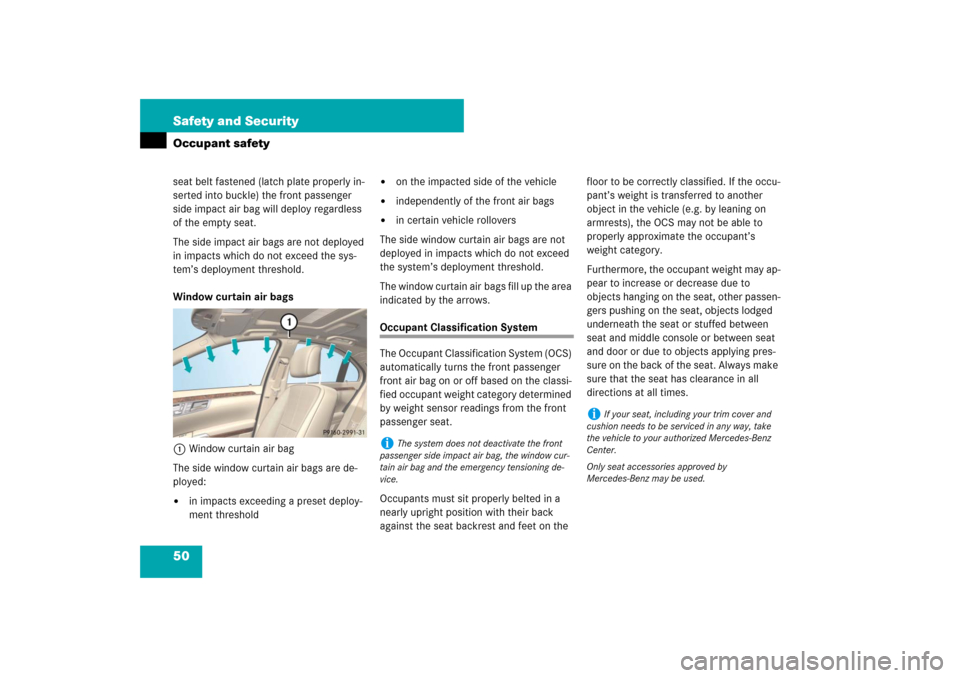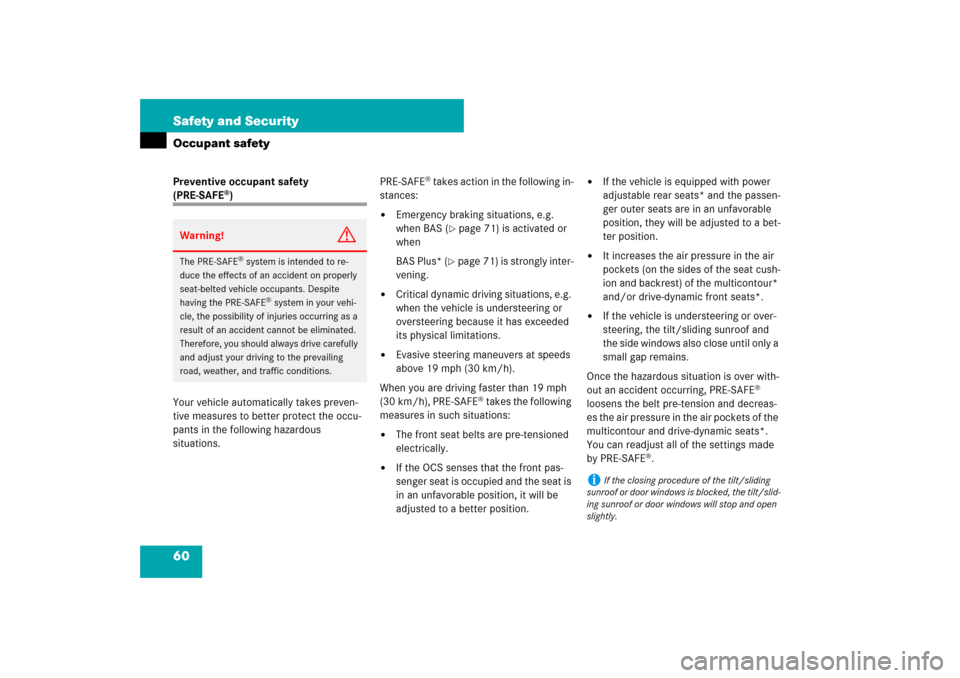Page 34 of 705
33 At a glance
Center console
Lower part
Item
Page
1
Favorite button
216
2
Rear head restraints retract
button
325
3
Program mode selector
switch for:�
automatic transmission
shift program
�
suspension tuning of
Airmatic (only S 550) or
ABC*
�
engine control
374
4
Shortcut button for: �
radio
�
CD/DVD
94
111
5
Back button
87
Item
Page
6
Hazard warning flasher
348
7
Seat operation via COMAND:�
Lumbar support
�
Multicontour seat*
�
Drive-dynamic
multicontour seat*
236
237
237
240
8
Shortcut button for:�
telephone*
�
navigation
115
148
9
COMAND controller
82
a
COMAND on/off switch
79
b
Volume adjustment
89
c
Mute function
89
d
Telephone keypad
117
Page 35 of 705
34 At a glanceAutomatic climate controlOverview
Page 36 of 705
35 At a glance
Automatic climate control
Item
Page
1
Left side defroster vent, fixed
2
Left side air vent, adjustable
3
Left center air vent, adjust-
able
4
Thumbwheel for air volume
control for left center air vent
433
5
Thumbwheel for air volume
control for right center air
vent
433
Item
Page
6
Right center air vent, adjust-
able
7
Right side defroster vent,
fixed
8
Right side air vent, adjustable
9
Front climate control panel
36
a
Thumbwheel for left rear cen-
ter air vents
434
Item
Page
b
Left rear center air vent,
adjustable
c
Right rear center air vent,
adjustable
d
Thumbwheel for right rear
center air vents
434
e
Rear climate control panel*
434
Page 37 of 705
36 At a glanceAutomatic climate controlAutomatic climate control panel, front
Item
Page
1
AUTO mode for air distribu-
tion and volume, left
428
2
Temperature control, left
429
3
Manual fan speed adjust-
ment, left
429
4
Front defroster
429
Item
Page
5
Air recirculation
431
6
Climate control on/off
428
7
Residual engine heat and
ventilation (REST)
433
8
Rear window defroster
430
Item
Page
9
Manual fan speed adjust-
ment, right
429
a
Temperature control, right
429
b
AUTO mode for air distribu-
tion and volume, right
428
Page 51 of 705

50 Safety and SecurityOccupant safetyseat belt fastened (latch plate properly in-
serted into buckle) the front passenger
side impact air bag will deploy regardless
of the empty seat.
The side impact air bags are not deployed
in impacts which do not exceed the sys-
tem’s deployment threshold.
Window curtain air bags
1Window curtain air bag
The side window curtain air bags are de-
ployed:�
in impacts exceeding a preset deploy-
ment threshold
�
on the impacted side of the vehicle
�
independently of the front air bags
�
in certain vehicle rollovers
The side window curtain air bags are not
deployed in impacts which do not exceed
the system’s deployment threshold.
The window curtain air bags fill up the area
indicated by the arrows.
Occupant Classification System
The Occupant Classification System (OCS)
automatically turns the front passenger
front air bag on or off based on the classi-
fied occupant weight category determined
by weight sensor readings from the front
passenger seat.
Occupants must sit properly belted in a
nearly upright position with their back
against the seat backrest and feet on the floor to be correctly classified. If the occu-
pant’s weight is transferred to another
object in the vehicle (e.g. by leaning on
armrests), the OCS may not be able to
properly approximate the occupant’s
weight category.
Furthermore, the occupant weight may ap-
pear to increase or decrease due to
objects hanging on the seat, other passen-
gers pushing on the seat, objects lodged
underneath the seat or stuffed between
seat and middle console or between seat
and door or due to objects applying pres-
sure on the back of the seat. Always make
sure that the seat has clearance in all
directions at all times.i
The system does not deactivate the front
passenger side impact air bag, the window cur-
tain air bag and the emergency tensioning de-
vice.
i
If your seat, including your trim cover and
cushion needs to be serviced in any way, take
the vehicle to your authorized Mercedes-Benz
Center.
Only seat accessories approved by
Mercedes-Benz may be used.
Page 61 of 705

60 Safety and SecurityOccupant safetyPreventive occupant safety (PRE-SAFE
®)
Your vehicle automatically takes preven-
tive measures to better protect the occu-
pants in the following hazardous
situations.PRE-SAFE
® takes action in the following in-
stances:
�
Emergency braking situations, e.g.
when BAS (
�page 71) is activated or
when
BAS Plus* (�page 71) is strongly inter-
vening.
�
Critical dynamic driving situations, e.g.
when the vehicle is understeering or
oversteering because it has exceeded
its physical limitations.
�
Evasive steering maneuvers at speeds
above 19 mph (30 km/h).
When you are driving faster than 19 mph
(30 km/h), PRE-SAFE
® takes the following
measures in such situations:
�
The front seat belts are pre-tensioned
electrically.
�
If the OCS senses that the front pas-
senger seat is occupied and the seat is
in an unfavorable position, it will be
adjusted to a better position.
�
If the vehicle is equipped with power
adjustable rear seats* and the passen-
ger outer seats are in an unfavorable
position, they will be adjusted to a bet-
ter position.
�
It increases the air pressure in the air
pockets (on the sides of the seat cush-
ion and backrest) of the multicontour*
and/or drive-dynamic front seats*.
�
If the vehicle is understeering or over-
steering, the tilt/sliding sunroof and
the side windows also close until only a
small gap remains.
Once the hazardous situation is over with-
out an accident occurring, PRE-SAFE
®
loosens the belt pre-tension and decreas-
es the air pressure in the air pockets of the
multicontour and drive-dynamic seats*.
You can readjust all of the settings made
by PRE-SAFE
®.
Warning!
G
The PRE-SAFE
® system is intended to re-
duce the effects of an accident on properly
seat-belted vehicle occupants. Despite
having the PRE-SAFE
® system in your vehi-
cle, the possibility of injuries occurring as a
result of an accident cannot be eliminated.
Therefore, you should always drive carefully
and adjust your driving to the prevailing
road, weather, and traffic conditions.
i
If the closing procedure of the tilt/sliding
sunroof or door windows is blocked, the tilt/slid-
ing sunroof or door windows will stop and open
slightly.
Page 71 of 705

70 Safety and SecurityDriving safety systemsThe pulsating brake pedal can be an indica-
tion of hazardous road conditions and
functions as a reminder to take extra care
while driving.
Emergency brake maneuver�
Keep continuous full pressure on the
brake pedal.
For more information, see “Practical hints”
(
�page 544).
Adaptive Brake
Adaptive Brake provides a high level of
braking safety as well as increased braking
comfort.Adaptive Brake Lights (S 600 and
USA only)
Depending on vehicle production date the
brake lamps flash in quick intervals while
you are braking in order to signal to cars
behind you that�
you are braking strongly at a speed of
more than 30 mph (50 km/h)
�
you are braking with the aid of BAS or
BAS Plus*
If you bring the car to a complete stop by
hard braking at a speed of more than
40 mph (70 km/h), the hazard warning
flasher automatically comes on as soon as
the vehicle is at a standstill. While the vehi-
cle is stationary, the brake lamps are con-
tinuously lit up. Once you drive faster than
6 mph (10 km/h) afterward, the hazard
warning flasher goes out.
Warning!
G
When the ABS is malfunctioning, the BAS,
BAS Plus*, ESP
® and ETS are also switched
off.
When the ABS is malfunctioning, the wheels
may lock during hard braking, reducing
steering capability and extending the brak-
ing distance.
Warning!
G
The ABS cannot prevent the natural laws of
physics from acting on the vehicle, nor can
it increase braking or steering efficiency
beyond that afforded by the condition of the
vehicle brakes and tires or the traction af-
forded. The ABS cannot prevent accidents,
including those resulting from excessive
speed in turns, following another vehicle too
closely, or hydroplaning. Only a safe, atten-
tive, and skillful driver can prevent acci-
dents.
The capabilities of an ABS equipped vehicle
must never be exploited in a reckless or dan-
gerous manner which could jeopardize the
user’s safety or the safety of others.
Page 72 of 705

71 Safety and Security
Driving safety systems
BAS
The Brake Assist System (BAS) operates in
emergency situations. If you apply the
brakes very quickly, the BAS automatically
provides full brake boost, thereby poten-
tially reducing the braking distance.�
Apply continuous full braking pressure
until the emergency braking situation is
over.
The ABS will prevent the wheels from
locking.
When you release the brake pedal, the
brakes function again as normal. The BAS
is then deactivated.
For more information, see “Practical hints”
section (
�page 544).
BAS Plus*
BAS Plus operates in emergency braking
situations and uses radar sensors to as-
sess the traffic situation.When you step quickly on the brake pedal
in an emergency braking situation,
BAS Plus automatically regulates the
brake pressure to a level that is suitable for
the traffic situation.
If BAS Plus requires a particularly high
brake pressure, PRE-SAFE
® is activated at
the same time.
�
Step on the brake pedal until the emer-
gency braking situation is over.
During this process, ABS prevents the
wheels from locking up.
Once you take your foot off the brake ped-
al or when there is no longer a risk of colli-
sion, the brake pedal functions again as
usual. BAS Plus is deactivated.
EBP
The Electronic Brake Proportioning (EBP)
enhances braking effectiveness by allow-
ing the rear brakes to supply a greater pro-
portion of the braking effort in straight line
breaking without a loss of vehicle stability.
Warning!
G
When the BAS is malfunctioning, the brake
system is still functioning normally, but with-
out the additional brake boost available that
BAS would normally provide in an emergen-
cy braking maneuver. Therefore, the braking
distance may increase.
Warning!
G
The BAS cannot prevent the natural laws of
physics from acting on the vehicle, nor can
it increase braking efficiency beyond that af-
forded by the condition of the vehicle brakes
and tires or the traction afforded. The BAS
cannot prevent accidents, including those
resulting from excessive speed in turns, fol-
lowing another vehicle too closely, or hydro-
planing. Only a safe, attentive, and skillful
driver can prevent accidents.
The capabilities of a BAS equipped vehicle
must never be exploited in a reckless or dan-
gerous manner which could jeopardize the
user’s safety or the safety of others.